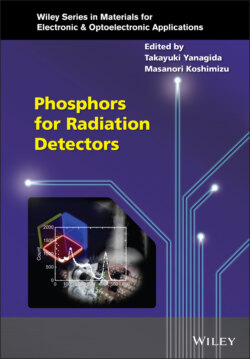Читать книгу Phosphors for Radiation Detectors - Группа авторов - Страница 2
Table of Contents
Оглавление1 Cover
2 Series Page
3 Title Page
4 Copyright Page
5 List of Contributors
6 Preface
7 Series Preface
8 1 Ionizing Radiation Induced Luminescence 1.1 Introduction 1.2 Interactions of Ionizing Radiation with Matter 1.3 Scintillation 1.4 Ionizing Radiation Induced Storage Luminescence 1.5 Relationship of Scintillation and Storage Luminescence 1.6 Common Characterization Techniques of Ionizing Radiation Induced Luminescence Properties References
9 2 Organic Scintillators 2.1 Introduction 2.2 Basic Electronic Processes in Organic Scintillators 2.3 Liquid Scintillators 2.4 Organic Crystalline Scintillators 2.5 Plastic Scintillators 2.6 Organic–Inorganic Hybrid Scintillators References
10 3 Inorganic Oxide Scintillators 3.1 Introduction 3.2 Crystal Growth 3.3 Outlines of Oxide Scintillators 3.4 Silicate Materials 3.5 Garnet Materials 3.6 Perovskite Materials 3.7 Materials with Intrinsic Luminescence References
11 4 Inorganic Fluoride Scintillators 4.1 Introduction 4.2 Crystal Growth of Fluorides 4.3 Outline of Fluoride Scintillators 4.4 Fluoride Scintillators for γ‐Ray Detection 4.5 Fluoride Scintillators for Neutron Detection 4.6 Fluoride Scintillators for Charged Particle Detection References
12 5 Inorganic Halide Scintillators 5.1 Introduction: History of Inorganic Halide Scintillator Research and Development 5.2 Characteristics of Halide Materials 5.3 Basic Techniques for Halide Scintillation Crystal Growth 5.4 Novel Ternary and Quaternary Halide Scintillators 5.5 Mixed‐Anion Halide Scintillators 5.6 Next Generation of Halide Scintillators References
13 6 Semiconductor Scintillators 6.1 Introduction 6.2 Photoluminescence and Scintillation Mechanisms in Semiconductors 6.3 Various Semiconductor Scintillators 6.4 Quantum Size Effect 6.5 Organic–Inorganic Perovskite‐Type Compounds References
14 7 Thermally Stimulated Luminescent (TSL) Materials 7.1 Introduction 7.2 TSL Phenomenon 7.3 TSL Materials: Fluoride, Oxides, Sulfates, and Borate 7.4 TSL Dosimetric Properties for Photons, Charged Particles, and Neutrons 7.5 Two‐Dimensional (2‐D) TSL Dosimetry References
15 8 Optically‐Stimulated Luminescent Dosimeters 8.1 Introduction 8.2 Principles of OSL Phenomenon 8.3 OSL Materials and Dosimeters 8.4 Applications of OSL 8.5 Future Perspective References
16 9 Radiophotoluminescence (RPL) 9.1 Introduction 9.2 RPL Phenomenon and the Definition 9.3 RPL Materials and Applications 9.4 Conclusions References
17 10 New Materials for Radiation Detectors 10.1 Introduction of Transparent Ceramic Materials 10.2 Preparation Methodology 10.3 Transparent Materials 10.4 Transparent Ceramic Scintillator 10.5 Transparent Ceramics for Dosimeter References
18 11 Luminescence in Glass‐Based Materials by Ionizing Radiation 11.1 Introduction 11.2 Structural and Physical Properties of Glass 11.3 Attenuation of Quantum Beam as Shielding Materials 11.4 Defect Formation in Oxide Glass by Quantum Beam Irradiation 11.5 Scintillation in Oxide Glass 11.6 Scintillation and Dosimetry in Non‐oxide Glass 11.7 Preparation of Glass 11.8 Future Prospectives for Glass‐Based Materials Acknowledgement References
19 12 Detectors Using Radiation Induced Luminescence 12.1 Introduction 12.2 General Issues to Manufacturing the Detector 12.3 Scintillation Detectors for Gamma‐Rays and X‐Rays 12.4 Scintillation Detectors for Charged Particles 12.5 Scintillation Detectors for Neutrons 12.6 Personal Dosimeters 12.7 OSL‐Based Imaging System References
20 Index
21 End User License Agreement
